|

< Back to Career archive
1972-1979: the GTV9 Audio Department
In the early 1970s I went through an epiphany that was to change my career. Seminal jazz-rock band “Blood Sweat & Tears” were in Melbourne and the concert at Festival Hall was to be recorded for later broadcast by GTV9. I was on the lighting crew and, when the rig was complete, I was assigned the job of follow-spot operator on lead singer David Clayton-Thomas. This put me at the rear of Festival Hall hard up against the tin roof and sandwiched between two Strand carbon-arc “Sunspots”. Of course, being Melbourne and being summer we copped a run of very hot days.
The first night was bad enough and I sweated gallons and, when the next day was forecast to be even hotter, I made sure I brought a bottle of water and operated in just a pair of flared jeans and a red leather plaited headband. Unfortunately, I put my bottle of water just out of reach and, because I was on the lead singer all night, had no opportunity to go and get it. By the end of the night I was dehydrated and exhausted. Television lighting may sound glamorous but, in reality, it was hard and dirty work, often right up amongst the heat of the lights. (And it could be quite dangerous, especially on the house ladder at Festival Hall, which was a huge A-frame affair with an extension ladder on one side. It was finally banned years later after a lighting guy at HSV fell off it and broke both his legs). Blood Sweat & Tears had brought with them one of the first Clair Brothers sound systems to arrive in Australia – large, JBL composite speakers that sounded much more like giant studio monitors than the tired old Altec theatrical boxes we were used to in Australia. Plus the sound crew had the latest complement of Shure microphones, including the SM53 which had an enormous front-to-back ratio enabling the rejection of feedback. The band cooked, and the sound was fabulous. I can remember sweating away at my follow-spot and listening to the wonderful sound and thinking “That’s what I want to do!”
With my engagement pending and my future father-in-law looking askance at the “unemployed” long-haired hippie in the mini-moke who was dating his daughter, it was time to get a full-time job again. In June 1972 I rejoined GTV in the audio department. My first day was as trainee boom operator on Division 4 with a 5.00 a.m. start. In those days, drama was covered with a single boom, usually with two alternating operators. Unfortunately, the main boom operator slept in and I was on my own. Having worked on Division 4 for a couple of years in the Lighting Department, I was quite comfortable about how a day in the studio worked. The problem was, I had never operated a boom before.
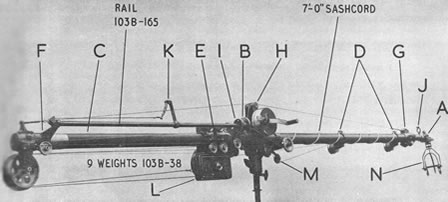
For the uninitiated, a Mole-Richardson studio boom is a daunting affair. It consists of a pair of long aluminium tubes, the inner of which can be extended while it is counterbalanced by a weight carriage travelling on the outside of the outer tube. The whole is pivoted about two thirds along its length on a mobile platform or “pram” on which the operator stands. The operator can extend and retract the arm by winding a handle mounted at the pivot H with his right hand. This enables the end of the boom on which the microphone is mounted to be moved to wherever the actors are standing in the set. The operator’s left hand controls the pan and tilt of the main boom arm and, independently, the microphone. Rotating the left hand K upwards and downwards pans the mic from side to side, while squeezing the handle controls the tilt of the mic in cradle N.
The key to the control of the entire boom is the index finger of the left hand which is looped over the pan-rail of the boom and controls the movement of the main arm in three dimensions. Every other movement is controlled by a network of wires and strings running on a pulley system. It takes a great deal of coordination to master this. I was later to realise that, out of five people trying to learn boom operation, one would eventually become a really competent operator suitable for television drama. This person was usually also a musician with the requisite hand independence already acquired. Of the other four people, two would become competent enough to manage single and dual talking-head situations like hostings and commercials, and the last two would never master the job.
Mastering the physical manipulation of the boom was one thing, but not the only thing the boom operator had to contend with. One of the most challenging was that you were sticking a large object right into a set filled with lights, and boom shadows were the inevitable consequence. These had to be kept out of shot at all times. Sometimes they could be hidden behind furniture and the boom kept still for the duration of the shot, but most of the time they had to be avoided altogether. This required the boom operator to create a mental three-dimensional picture of all the lighting beams in the set and move the arm and mic through this pattern in such a way as to avoid shadows either in the background of shots or on any of the actors. Arm shadows could often avoided by shifting the boom pram sideways in the set. Sometimes a minor re-frame of the camera could help, and sometimes one just had to ask the lighting boys to help by making an adjustment to the lighting. In this I had a head start, having worked in the lighting department, and I could tell when the refusal of an adjustment to the lighting to help out the boom operator was real “artistic integrity” and when it was just plain laziness!
A further complication also had to be dealt with. The mic had to be kept out of shot at all times and there were usually three cameras to contend with. The boom operator had a vision monitor mounted on the boom which showed the output of the vision switcher. The monitor was usually “under scanned” so that the operator could see the top of the actual picture outside of “television-safe”. The monitor enabled the operator to see boom shadows in frame and mic in shot during rehearsal and take the necessary corrective action. The mic was usually quite close to the top of most framed shots so that, just before a wide shot, the operator would have to “sky” the boom to get it out of the new shot and then drop it back in when the director cut tighter. In the average two to three-minute scene there might be a dozen shots, and all of these had to be memorised. One GTV cameraman on “Sullivans” developed a technique of blaming the boom operator whenever that cameraman was dissatisfied with the way his shot was going – he would tilt up quickly and call “boom in shot”. Good boom operators quickly learnt to read his body language and sky the boom so that the camera was looking up at the grid before it caught the boom. A couple of instances of this and the consequent embarrassment cured that particular cameraman of that particular technique.
There were also the actors to contend with. Lines were scripted of course, but a subtle variation could easily “throw” the boom operator. Each speech had to be captured cleanly which meant the mic, which was quite directional, had to be pointing at the actor at the start of each speech. The boom operator had a script, on which he would note the inevitable minor script changes made during rehearsal.
This script was usually “marked-up” by the boom operator with symbols to demote whip pans, wide shots, entrances of new characters, and important words at the end of speeches that would cue the operator to move the mike to a new character. Sometimes an actor would reverse the order of sentences or words in a speech so that it still made sense for the plot, but the absence, change or different position of a critical word on which the operator was depending for a cue could destroy an otherwise good take. Some actors could deliver scenes word perfect, but there were many who could not and these people were always a special challenge to the boom operator.
And then there were the technical requirements to be dealt with. In the early 1970s cameras and audio mixers still had valves in them, and there was the noise floor in the audio mixer to contend with. The boom operator had to capture sufficient level from the actors to provide a signal to the control room which was high enough to negate the noise of subsequent electronic amplification. There is also a lot of extraneous noise in most studio environments. This included camera fans, iris and zoom motors, lens turrets (the lens changing mechanism), camera cables dragging on the floor, air-conditioning rumble, creaking, hum and buzz from lights and a host of other noises. Not only did the signal delivered to the control room have to be sufficiently far above this background noise, it had to be a consistent level above this so that scenes and “pickups” (partial takes) could be cut together without appreciable changes in the background noise. At GTV, the boom operator had to call “fans off and turrets on slow revolve” at the commencement of each take to remind the cameramen of this essential task. Some studios were good for background and some studios not so good. Studio 9 at GTV was quite good, but the Crawford’s studio in which “Sullivans” was shot suffered by being next to a building site and even from audible interference from birds nesting in the trees along the north wall. An experienced actor with stage experience was always a joy to work with because they generally had good voices, but younger and less experienced actors with soft voices were always a challenge. Even the boom itself was a restriction. They all suffered to a greater or lesser degree from “rumble” through fast racking, wind noise when panning the mic fast, and various squeaks and groans from the inner arm twisting within the outer arm. The boom had to be operated within its physical limits and, once every year (generally over Christmas), dismantled, cleaned, lubricated, re-strung and “re-tuned” for optimum performance. (The worn-out Mole-Richardson booms on which I started my career were a real challenge which had to be overcome until eventually they were replaced with new J. L. Fisher booms).
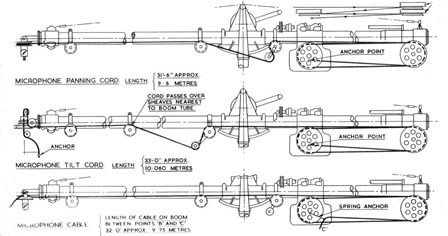
Having mastered all of this, there was a final challenge laid over the top which only the better boom operators ever mastered. This was something called audio perspective. It required the operator to match the sound he was capturing with the shot on the screen by careful attention to the sound he was producing in his headphones. In an extreme close up the mic had to be as close to the actor as you could get it. On a wide shot, even if you could get quite close to the actor, you stayed loose so you heard more of the room and a little less of the direct sound. Let me explain. An actor walks into an empty room in a wide shot and calls out. The boom is loose to give the feeling of an empty room. The camera cuts to a close-up of a telephone which rings. The boom mike has to be tight on the telephone, (and in position before it starts ringing if the ring is “live”). We hear the actor walk towards the telephone off-camera and off-mike, and the boom pans up with the camera as the telephone is answered. As the boom moves up to the actor the camera tracks in as this is obviously bad news.
The camera shot is tight on the actor’s face as the bad news is received, and the closeness of the boom conveys the intensity of emotion as the actor speaks. The telephone receiver is replaced, and the actor runs from the room in a wide shot. The skyed boom captures retreating footsteps echoed in the room. A good “perspective” from the boom was usually also a challenge for the audio director who had to control the level of sound going to tape for a consistent signal. Nowadays, in the digital age, a lot of this can be fixed in post production but, back in the 1970s, all sound was recorded direct to analogue monophonic videotape and the soundtrack had to be pretty much complete except for music and special sound effects when it was laid down.
So, we have a Heath Robinson affair of strings and pulleys to contend with, a studio environment littered with troublesome boom shadows, a desperate attempt to stay out of the shots of three separate cameras, wayward actors improvising with the script, technical challenges to be met, compensation made for the failings of that particular boom (and they were all different), and over all that, an attempt to give your work artistic as well as technical merit. So here I was, on my first day, both hands hard at work on the as yet unfamiliar boom controls and turning script pages, one eye on the mic, one eye on the boom shadows, one eye on the monitor, one eye on the actors, one eye on the script, one ear on the program and one ear on the talkback listening for the “cut” calls, all alone on the boom, and with only the distant voice of audio director Ken Whytecross on the end of the talkback to give me guidance. Luckily the first few scenes were pretty simple, and I struggled through them. My only saving grace was my familiarity with the drama studio environment. By the time my boom “instructor” finally turned up, I had the rudiments almost under control. Over the ensuing years I became boom operator on most of GTV’s variety shows and specials as well as on the following dramas: “Division 4”, “Sullivans”, “Prime Time”, “Prisoner”, “Cop Shop”, “Skyways” and “Neighbours”. Today, “Neighbours” is practically alone in Australia in continuing the use of studio boom in three-camera studio drama. It is only productions like these which are keeping the art of the boom operator alive and well, but even they struggle at times, and I was filling in as emergency boom operator on “Neighbours” as late as 2004.
One of the jobs I enjoyed most during my early years in the Audio Department was “News TT’s” [News Turntables]. All of the news in those days was shot on 16mm film cameras, of which few had the “mag-stripe” facility to record sound on location. A lot of the stories shot by “stringers” (freelance cameramen) were only shot on hand-held clockwork Bolex cameras and the film sent into the studio by taxi!
Voice-overs for the edited news stories were done live from the booth. However, a story without sound effects is pretty unconvincing. The news at GTV came out of the old IMT band shell in Studio 1 using the Studio 1 control room. The Studio 1 audio mixer was an old Pye valve affair with Painton quadrant faders controlling the valve mic amplifiers racked up in nearby Master Control. Sitting to one side of the audio mixer was a set of four 15-inch diameter rim-drive turntables with a small sub-mixer. Behind this were four filing cabinet drawers of 78 rpm sound effect records. An exercise book listed the contents of all the records in alphabetical order, so it didn’t take long to find the sound effect you required.
At about 4.00 pm I would wander up to the news room and watch the stories being cut together. Strips of film were hung from small nails on wooden bars over large calico bags (to stop the film from getting scratched). The editors would be busy at their flat-bed editing machines assembling the stories from the raw film fresh from the developing room by splicing the scenes together mechanically. By looking over the shoulders of the editors at the flickering images on the screens I could work out what sound effects I would need. The most basic and often played sound effects were traffic and crowd (“Standard” discs 215 and 268 which starred in almost every news story and semi-permanently occupied two of the four turntables). Night scenes invariably need crickets and frogs, construction sites a compressor, fires the fire FX disc and a hose (“washing car” was the favourite sound), farm scenes “birdies” and the appropriate animals, seagulls and waves for the beach and so on. Once I had my notes I would go back down and get the appropriate discs out. By the time the news went to air they were all arrayed around the four turntables and I was standing by. Those discs got pretty rough treatment. The control room was fairly cramped and, if a sound effect was not required again, the disc would be tossed aside to make more room. Some stories just required sound beds, others required both beds and spot effects which would have to be played on cue (like breaking glass, which was a favourite for when a tow truck pulled two cars apart). There were a couple of special tricks. If the camera was just panning around an empty room, I played a film projector sound effect. When in doubt, the label of any record could be played to produce a nondescript sound effect. Helicopters were my favourite. If a helicopter was taking off, the sound effect could be started at 45 rpm, then flicked to neutral while the record was sped up to 78 rpm by hand to mimic the take off of the helicopter. Landings could be done by carrying out the speed changes in a reverse order. Model aeroplanes were done by using a power-boat race disc and playing it manually at about 100rpm! The final stories of the sports segment were often the races. “Sports Challenge” was played underneath the race call and faded out as soon as the third place was called.
Most operators played the standard English “Dawn Chorus” when birdies were called for. However, one operator, John Prendergast , preferred a record of bell-birds as it was a more Australian sound. Trouble was, he used it under just about every story. After numerous complaints, the News Director came down and smashed the bell-bird record. Next night, just about every story had bell-birds in it again. Again the record was seized and smashed. This process continued for some time until John had used up the entire carton of bell-bird records he had purchased as a “job lot”, and the English Dawn Chorus reigned supreme once again.
It was only some years later when we finally obtained some cartridge machines that the old turntables were phased out. However, they were still used in other studios for music replays, especially in station promo production.
In the days when records actually had a finish on them rather than a fade-out, a 30-second track could be reliably obtained by winding a 33 rpm record back 15 revolutions from the end of the track and picking the nearest first beat in the next bar as a starting point. We all became very competent at slip starting a record with one finger on the rim and the other hand on the fader ready to throw it up as soon as the record was up to speed.
Next page >
|
 |
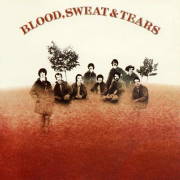
Blood Sweat & Tears – an epiphany at their Melbourne concert induced me to forsake lighting for a career move into audio
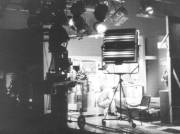
A Mole-Richardson microphone boom diagram (left) and in use in “Vicker’s Office” on the set of Crawford Productions “Division 4” (right)
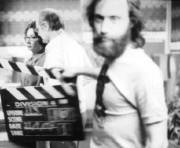
Russ Karel with the clapper board for a scene in episode 113 of “Division 4”
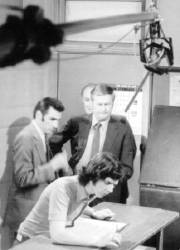
On the set of “Division 4” – floor manager Wayne Rogers checks the shooting script in the “Charge Counter” set
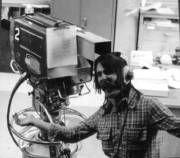
Cameraman Scott Duncan hams it up on “Division 4”
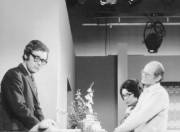
A very young Ian Smith (left), now of “Neighbours”, on the set of “Division 4” in the early 1970s

Ken Whytecross at the audio console in Studio 9 which was used for recording “Division 4”
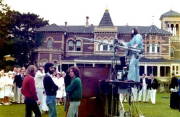
Peter on the boom at Ripponlea on an American-produced Glen Campbell Special. The talent was Sherbet singing their hit “Howzat” – someone had told the Americans that “Howzat” was somehow related to bowling – but forgot to tell them which kind, as a result of which the song was shot in the midst of about 100 Lawn Bowlers!
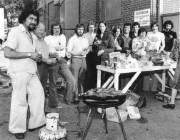
“The Sullivans” studio crew at the Friday night BBQ held out the back of the Crawford’s studios at Abbotsford. From left to right: Mike Mato, Eric Larsen, Peter Evans, Bob Castleton, Paul McNaughton. Laurie Fish, Jenny Williams, Mark ??, Drew Whitehead, Gary Dunstan, Terry Higgins, Laurie “Pancho” Levy. Just obscured on the right is the actress who played “Mrs Kauffman”. Alcohol was allowed at these BBQs but, after an incident when an actress had “one too many” and had to be force-fed black coffee and marched up and down the studio stairs by a production assistant, alcohol was banned. Friday was a very long day, starting at 7.00 am and often finishing at midnight. If it was summer and the air-conditioning broke down (as it often did), these nights could become even longer...
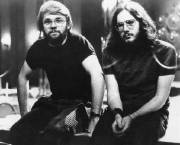
John Weston (left) and Peter Evans (right) on the set of “Mrs Victoria” in the early 1970s
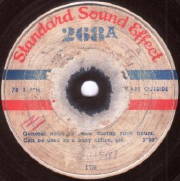
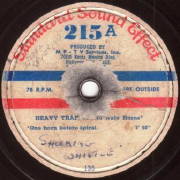
Standard Sound Effect 215 (traffic) and 268 (crowd) – heroes of many a GTV9 news service, and showing clear signs of the operator having to often resort to playing the label ...
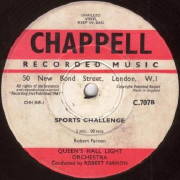
Chappell Music’s “Sports Challenge opened and closed many a GTV football telecast and supported the race reports at the end of the news bulletins
|
